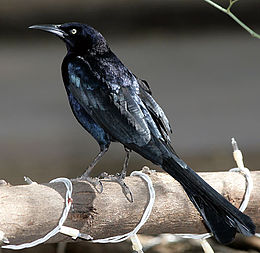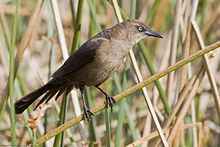- Great-tailed Grackle
-
Great-tailed Grackle 
Conservation status Scientific classification Kingdom: Animalia Phylum: Chordata Class: Aves Order: Passeriformes Family: Icteridae Genus: Quiscalus Species: Q. mexicanus Binomial name Quiscalus mexicanus
(JF Gmelin, 1788)The Great-tailed Grackle (Quiscalus mexicanus) is a medium-sized, gregarious passerine bird native to North and South America. A member of the Icteridae family, it is of the ten extant species of grackle and is closely related to the Red-bellied Grackle and the Velvet-fronted Grackle. It is sometimes referred to as a "blackbird", though it is not a member of the New World blackbirds, nor is it related to any of the five species of Old World blackbirds (all of which are species of the Turdus genus). Similarly, it is often called "cuervo" in areas of Mexico, although it is not a member of the Corvus genus, nor even of the Corvidae family.
Contents
Description
Males reach up to 43 cm (17 in), including a tail that is almost as long as the body, weigh 230 g, and are jet-black with a violet-blue iridescent sheen to the feathers. Females are significantly smaller at 33 cm (13 in), weigh 125 g, and are mainly brownish-black, with a pale brown throat and belly. This morphological difference between males and females of a species is known as sexual dimorphism.
The Great-tailed Grackle and Boat-tailed Grackle were once considered the same species. Some species of grackle, usually the Great-tailed, are confused with an American Crow when people unfamiliar with bird identification are asked to identify a dead blackbird. This usually occurs when birds need to be identified as candidates for West Nile virus.
Distribution and habitat
Its range stretches from Kansas in the northeast to southern California in the northwest down to northwest Peru and northwest Venezuela in the south; the grackle's range has been expanding north and west in recent years. It is common in Texas and Arizona in the southern regions. It is commonly found in agricultural regions and suburban environments, feeding on fruits, seeds, and invertebrates.
Behavior
This bird has a large variety of raucous, cacophonous calls, and is widely considered to be a noisy pest species, though its range expansion has not been aided by human introduction (compared to the European Starling). The females can travel in flocks and they share food. When a male spots a female, he engages her by puffing up and gaping his mouth. He then proceeds to make loud calls and follow the female. The female will allow the large males to mate with her; she will usually reject smaller males.
References
- BirdLife International (2004). Quiscalus mexicanus. 2006. IUCN Red List of Threatened Species. IUCN 2006. www.iucnredlist.org. Retrieved on 12 May 2006. Database entry includes justification for why this species is of least concern
- Hilty, Birds of Venezuela, ISBN 0-7136-6418-5
- Stiles and Skutch, A guide to the birds of Costa Rica ISBN 0-8014-9600-4
- "Quiscalus mexicanus". Integrated Taxonomic Information System. http://www.itis.gov/servlet/SingleRpt/SingleRpt?search_topic=TSN&search_value=179109. Retrieved 6 February 2006.
External links
- Great-tailed Grackle at Avibase
- Great-tailed Grackle at USGS
- South Dakota Birds - Great-tailed Grackle Information and Photos
- Great-tailed Grackle at Animal Diversity Web
- Great-tailed Grackle Movies on the Internet Bird Collection
- Great-tailed Grackle Movies (Tree of Life)
Further reading
- Johnson, K., and B. D. Peer. 2001. Great-tailed Grackle (Quiscalus mexicanus). In The Birds of North America, No. 576 (A. Poole and F. Gill, eds.). The Birds of North America, Inc., Philadelphia, PA.
Categories:- IUCN Red List least concern species
- Quiscalus
- Birds of Central America
- Birds of Mexico
- Birds of the United States
Wikimedia Foundation. 2010.


